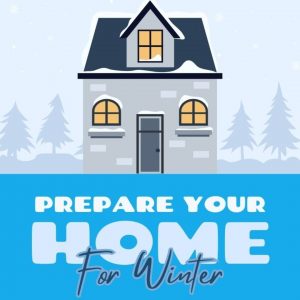13 Tips for Winterizing Your Home

Winter is coming! That means cold weather, wind, rain, snow and ice are just around the corner. As a homeowner, it’s important to start winterizing your home before the season sets in. Doing so will help to keep your home safe, prevent damage and save you money on heating costs. Not sure where to start? Check out these 13 tips:
- Clean out gutters. When gutters and downspouts are filled with leaves and other debris, rainwater can overflow. Routine gutter cleaning is essential to avoid water damage to your roof and home. There are several gutter cleaning tools available that allow you to do all the work from the ground level. If you opt for using a ladder, be sure to practice ladder safety. To prevent this tedious task in the future, consider installing a screen that allows water to pass through but blocks debris.
- Conduct a roof inspection. It’s important to inspect your roof for missing shingles, exposed nails, defective flashings and any other issue that may result in damage if not properly repaired. You may be tempted to handle this task on your own, but hiring a professional is the best way to ensure accuracy. If your home is located in an area known for heavy snowfall, consider installing snow guards or heating cables to prevent ice dams from occurring.
- Install or replace weather stripping. According to the Environmental Protection Agency (EPA), homeowners can save an average of 15 percent on heating costs by air sealing their homes and adding proper insulation. So, be sure to check that your doors and windows properly close, and adjust or install new weather stripping to get a better seal. For a list of the most common types of weather stripping, click here.
- Caulk cracks. Another effective air-sealing technique is rubber or silicone caulking. Caulking can also be used as to create a waterproof seal for leaks in faucets, water pipes and other plumbing fixtures.
- Inspect insulation. Attics, crawl spaces and pipes should be at the top of your list for inspecting insulation, as poor insulation makes for a cold home. More importantly, poor or damaged insulation can lead to serious health hazards such as mold, allergen collection and pest nesting.
- Protect pipes. Quick drops in outdoor temperature, poor insulation and thermostats set too low can cause your water pipes to freeze and expand, potentially causing a crack in your plumbing system. Even the smallest of cracks can emit thousands of gallons of water, causing significant water damage to your home. Prior to winter, install pipe insulation to interior pipes and heat tape directly to exterior pipes to prevent freezing.
- Clean your chimney. There’s nothing like sitting next to the fireplace during the winter months, but not if it hasn’t been adequately cleaned. A dirty chimney poses risks to your health and your home, such as carbon monoxide poisoning and fire danger. To learn ways to prevent chimney dangers, review the Federal Emergency Management Agency (FEMA)’s fire precautions and carbon monoxide safety materials.
- Set your programmable thermostat. Programming your thermostat can help to achieve proper heating and greater energy savings.
- Inspect heating appliances. Staying warm during the winter requires your heating sources – such as HVAC systems, boilers, furnaces and radiators – to be in working order. It’s important to schedule an inspection before the cold weather hits. The inspection will also ensure that you and your family are safe from hazards such as leaks that can cause carbon monoxide exposure.
- Change furnace filters. To improve air quality in your home during the winter, it’s recommended to change your furnace filters every month. Changing the filter in a timely manner is a simple way to eliminate pollutants, dust and allergens from your home. It also helps the furnace run smoothly, avoiding unnecessary energy costs or expensive repairs.
- Protect entryways. During the winter months, snow, water and dirt will invade your entryways. Safeguard your floors by placing doormats both inside and outside doors. To avoid trekking remnants of the weather throughout the home, create a mudroom.
- Test your smoke and carbon monoxide detectors. The U.S. Fire Administration reports that half of all heating fires occur in the months of December, January and February. It’s important to test your detectors before the cold weather strikes. Doing so will help to protect your family from fires and carbon monoxide poisoning.
- Reverse ceiling fans. Running your ceiling fan on low in a clockwise direction in the winter forces warm air that naturally rises to the ceiling downward.
Winterizing your home helps to prevent potential disasters and unnecessary repairs. It also saves money and provides peace of mind.
See more at…https://www.oldrepublictitle.com/blog/home-winterizing/